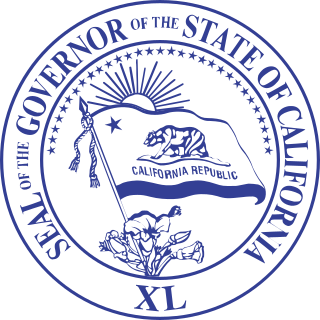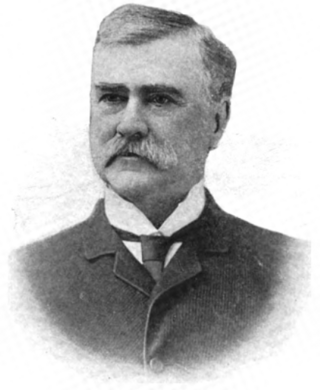Related Research Articles

The governor of California is the head of government of the U.S. state of California. The governor is the commander-in-chief of the California National Guard and the California State Guard.

The government of California is the governmental structure of the U.S. state of California as established by the California Constitution. California uses the separation of powers system to structure its government. It is composed of three branches: the executive, consisting of the governor of California and the other constitutionally elected and appointed officers and offices; the legislative, consisting of the California State Legislature, which includes the Assembly and the Senate; and the judicial, consisting of the Supreme Court of California and lower courts. There is also local government, consisting of counties, cities, special districts, and school districts, as well as government entities and offices that operate independently on a constitutional, statutory, or common law basis. The state also allows direct participation of the electorate by initiative, referendum, recall and ratification.

The California State Legislature is a bicameral state legislature consisting of a lower house, the California State Assembly, with 80 members; and an upper house, the California State Senate, with 40 members. Both houses of the Legislature convene at the California State Capitol in Sacramento. The California state legislature is one of just ten full-time state legislatures in the United States. The houses are distinguished by the colors of the carpet and trim of each house. The Senate is distinguished by red and the Assembly by the color green, inspired by the House of Lords and House of Commons respectively.

The Supreme Court of California is the highest and final court of appeals in the courts of the U.S. state of California. It is headquartered in San Francisco at the Earl Warren Building, but it regularly holds sessions in Los Angeles and Sacramento. Its decisions are binding on all other California state courts. Since 1850, the court has issued many influential decisions in a variety of areas including torts, property, civil and constitutional rights, and criminal law.

The Minnesota Supreme Court is the highest court in the U.S. state of Minnesota. The court hears cases in the Supreme Court chamber in the Minnesota State Capitol or in the nearby Minnesota Judicial Center.

The Supreme Court of Florida is the highest court in the U.S. state of Florida. It consists of seven justices–one of whom serves as Chief Justice. Six members are chosen from six districts around the state to foster geographic diversity, and one is selected at large.
Robert Francis Morrison was the 13th Chief Justice of California from November 1879 to March 2, 1887, when he died in office.

Jackson Temple was an associate justice of the Supreme Court of California. He served three separate terms on the court between 1870 and 1902.
Henry Augustus Lyons was the second Chief Justice of California, appointed to the court by the California State Legislature at the formation of the state. He was the first Jewish justice on the court.
Augustus Loring Rhodes was the 10th Chief Justice of California.

The Supreme Court of Georgia is the highest judicial authority of the U.S. state of Georgia. The court was established in 1845 as a three-member panel. Since 1896, the justices have been elected by the people of the state. The justices are currently elected in statewide non-partisan elections for six-year terms, with any vacancies filled through an appointment by the Governor.
The Constitution of the State of Wisconsin is the governing document of the U.S. State of Wisconsin. It establishes the structure and function of state government, describes the state boundaries, and declares the rights of state citizens. The Wisconsin Constitution was written at a constitutional convention held in Madison, Wisconsin, in December 1847 and approved by the citizens of Wisconsin Territory in a referendum held in March 1848. Wisconsin was admitted to the United States on May 29, 1848. Although it has been amended over a hundred times, the original constitution ratified in 1848 is still in use. This makes the Wisconsin Constitution the oldest U.S. state constitution outside of New England. Only Massachusetts, New Hampshire, Vermont, Maine, and Rhode Island use older constitutions.

The New Mexico Supreme Court is the highest court in the U.S. state of New Mexico. It is established and its powers defined by Article VI of the New Mexico Constitution. It is primarily an appellate court which reviews civil and criminal decisions of New Mexico's trial courts of general jurisdiction and certain specialized legislative courts, only having original jurisdiction in a limited number of actions. It currently resides in the New Mexico Supreme Court Building in Santa Fe.

The Minnesota Court of Appeals is the intermediate appellate court in the U.S. state of Minnesota. It began operating on November 1, 1983.

Elisha Williams McKinstry was a California jurist of the nineteenth century. He served as a justice of the California Supreme Court from 1874 to 1888.
In the United States, the government of each of the 50 states is structured in accordance with its individual constitution. In turn, each state constitution must be grounded in republican principles. Article IV, Section 4, Clause 1 of the United States Constitution tasks the federal government with assuring that each state's government is so organized.
Nathaniel Bennett was one of the first Associate Justices of the California Supreme Court.

The Judiciary of California or the Judicial Branch of California is defined under the California Constitution as holding the judicial power of the state of California which is vested in the Supreme Court, the Courts of Appeal and the Superior Courts. The judiciary has a hierarchical structure with the California Supreme Court at the top, California Courts of Appeal as the primary appellate courts, and the California Superior Courts as the primary trial courts.

John Randolph Sharpstein was an American lawyer and judge. He was an associate justice of the Supreme Court of California for twelve years, and previously served as a member of the Wisconsin State Senate and Wisconsin State Assembly.

The 2022 California elections took place on November 8, 2022. The statewide direct primary election was held on June 7, 2022.
References
- ↑ "California Constitution". California Legislature. Retrieved September 27, 2017. Art. VI, Sec. 1.
- ↑ "California Constitution". California Legislature. Retrieved September 27, 2017. Art. VI, Sec. 2, 7, 16(a).
- ↑ "California Constitution". California Legislature. Retrieved September 27, 2017. Art. VI, Sec. 7.
- 1 2 "California Constitution". California Legislature. Retrieved September 27, 2017. Art. VI, Sec. 16.
- ↑ "Chief Justice, Supreme Court of California salary". Publicpay.ca.gov. California State Controller. Retrieved September 29, 2017.
- 1 2 "Records of the Constitutional Convention of 1849". California Secretary of State. Retrieved September 27, 2017. Art. VI, Sec. 2, 3.
- 1 2 The Supreme Court of California (PDF) (7th ed.). Sacramento, CA: Supreme Court of California. 2016. pp. 13, 16. Retrieved September 28, 2017.
- ↑ "Happy Trails, Justice Werdegar". California Constitution Center at UC Berkeley Law and the Hastings Law Journal. SCOCA Blog. March 17, 2017. Retrieved September 27, 2017.
- ↑ "Governor Brown to Swear In Mariano-Florentino Cuéllar and Leondra Kruger to the California Supreme Court" (Press release). Sacramento, California. Governor of California. 2014-12-22. Retrieved 2014-12-24.
- ↑ Luna, Taryn (January 3, 2019). "Joshua Groban, aide to Gov. Jerry Brown, sworn in to California Supreme Court". The Los Angeles Times . Retrieved 7 January 2019.
- ↑ "Governor Newsom Swears in Justice Martin Jenkins to the California Supreme Court" (Press release). Sacramento, California. Governor of California. 2020-12-04. Retrieved 2020-12-08.
- 1 2 "Two Justices Make History in California Supreme Court". KSRO . January 4, 2023. Retrieved 17 January 2023.